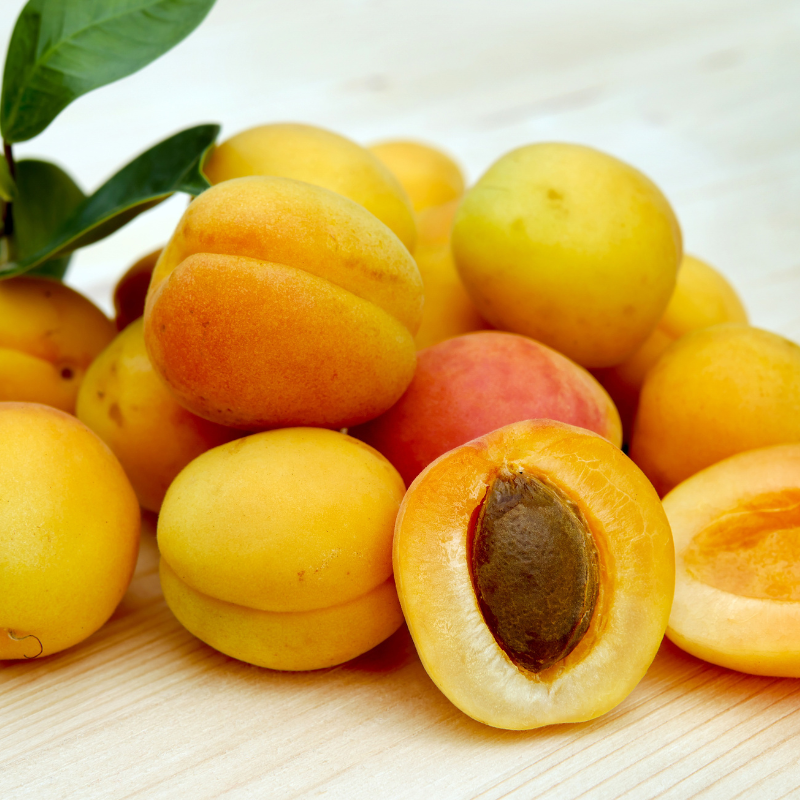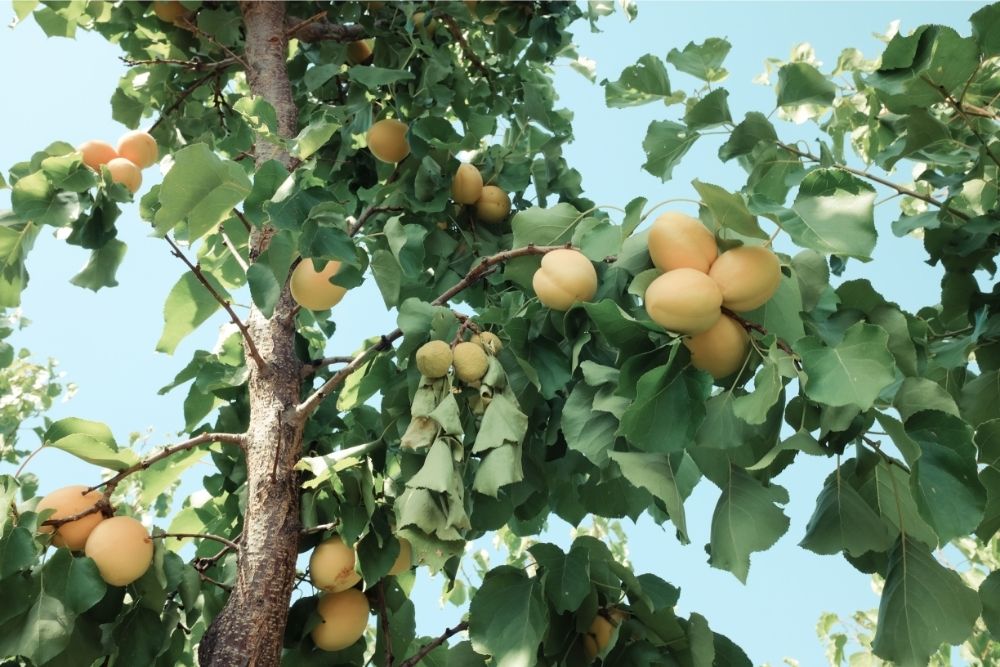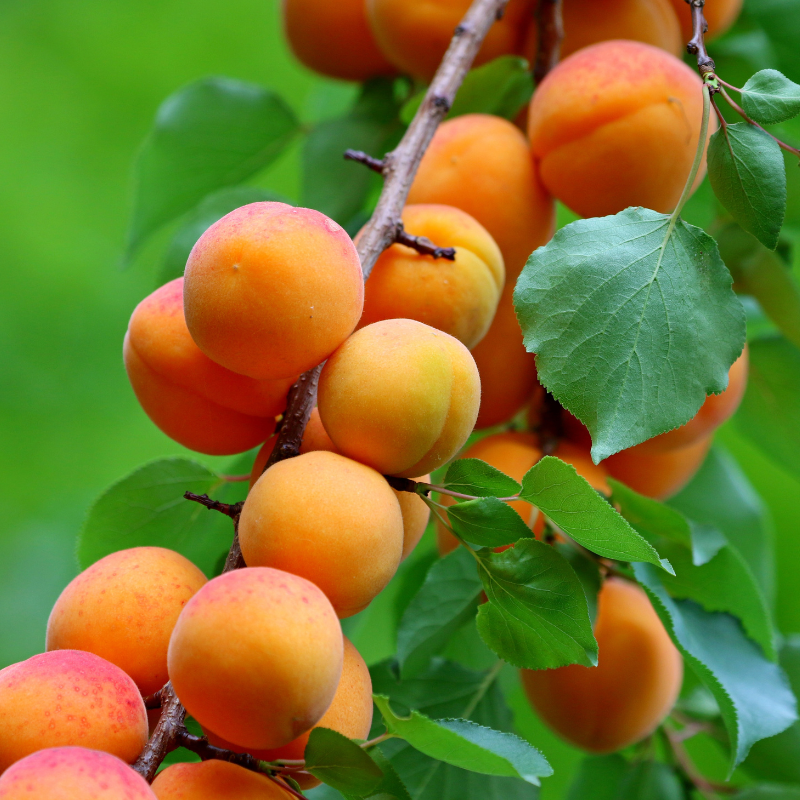Apricots are considered to be golden little fruits that are packed with antioxidants, fiber, and a whole host of vitamins.
The old saying goes “an apple a day keeps the doctor away” but this could so easily be about apricots too.
These little gems have numerous benefits such as helping improve eyesight, skin condition, and digestion.

There is nothing better than freshly picked apricots in your very own backyard. Not only are these fruits eye-catching, but they are supremely tasty.
Best of all, there are multiple varieties of apricot trees that you can grow at home. Once you plant an apricot tree in your yard, these fruits may become your favorite of the lot!
Apricots tend to have a special place in many people’s hearts. They remind them of long summer days, picking fruit with family and friends.
Even their lush and sweet scent combined with their juicy bite brings back special memories of a by-gone time.
If you want to bring those memories flooding back or want to start cultivating apricots in your yard, then we are here to help.
In today’s article, we will be guiding you through the different types of apricot trees for you to consider planting at home.
1. Royal Rosa

We start with the Royal Rosa apricot tree.
This is perfect for those looking to grow one in their backyards where temperatures rarely stay cold enough for apricot trees that require cooler conditions.
Many fruit trees require a certain number of chill hours to flower and bear fruit. While some need as few as 100 hours, the Royal Rosa needs around 400. Compared to many, this is still pretty low.
With a pure white bloom color and a maximum height of around 15 to 18 feet (5.49 m), the Royal Rosa apricot tree is a great addition to any yard.
As for the apricots themselves, these can be freshly eaten straight from the tree, dried, preserved, or canned.
2. Golden Sweet

A beautiful bloom color of pink and white helps the Golden Sweet apricot tree stand out from many others.
This is a typical example of a picturesque apricot tree that is ideal for home orchards.
Not only is this a pretty tree, but it also produces delicious apricots that can be freshly eaten straight from the branches.
These apricots are also perfect for drying and baking.
3. Dwarf Divinity

The Dwarf Divinity is small to a medium-sized apricot tree that produces high yields of regular-sized Divinity apricots. If you have a small backyard, these trees would be a great option.
The fruit from Dwarf Divinity trees tends to have a sweet flavor and is superb for both drying and fresh eating. If you’re looking for some high-quality, early-season apricots, this tree is one of the best.
However, when the tree is young, it ripens later in the season. As it gets older, the self-fertile Dwarf Divinity becomes a heavy bearer of medium-sized fruits.
4. Autumn Glo

The Autumn Glo is a favorite of many apricot tree cultivators.
This classic, freestone tree (fruits with a pit that isn’t attached to their flesh) requires 500 chill hours, and has a mature spread of 12 to 15 feet (4.57 m), and also reaches a maximum height of 12 to 15 feet (4.57 m).
The bloom color of pink is a wonderful sight to behold and the apricots produced from the Autumn Glo tree can be freshly eaten, baked, and/or canned.
5. Chinese

The Chinese apricot tree is considered a semi-dwarf type.
Self-pollinating, this is a hardy tree that grows in zones 4-7 and requires a 700 hour chill time. These late-blooming trees are also known as ‘Mormon’ trees and produce heavy harvests during midsummer.
The fruits of the Chinese apricot tree are small to medium-sized with a red blush atop their orange skins. When tucking into these apricots, they are firm but juicy.
Their flesh is freestone with a sweet, mild taste. They are also great for fresh eating, baking, drying, and canning.
And, it gets better as these Chinese apricots tend to develop edible pits that are eaten like almonds.
Unique!
RELATED: How To Propagate Chinese Money Plant: What You Need To Know
6. Patterson

Zone 4 is infamous for its difficulty in growing fruit trees due to its chilly climate.
If you live in this region, then do not despair as the Patterson apricot tree may be the answer to your apricot prayers.
Requiring 700 to 1,000 chill hours, this apricot tree grows well in zones 4 to 9 and produces apricots that are suitable for fresh eating, freezing, and canning.
7. Goldest Kist

Able to grow as far north as zone 5, the Golden Kist apricot tree blooms supremely beautiful pink colors each year.
Golden Kist trees tend to grow between 15 and 25 feet (ca. 8 m) high but there are dwarf and semi-dwarf varieties available as well (these only reach around eight to 15 feet (4.57 m) in height).
Ideal for home cultivators, Golden Kist apricot trees do not have a wide spread. Even when matured, they have a width of approximately 10 to 20 feet (ca. 6 m).
The apricots themselves are ideal for fresh eating, baking, and canning.
8. Goldcot

We’re staying with the gold theme for this next entry on the list.
This Goldcot cultivar grows well in zones 4 to 8 with a high chill requirement of around 800 chill hours. A late bloomer, the Goldcot apricot tree is a self-pollinator whose fruits ripen during midsummer.
The apricots produced by this tree are medium to large-sized with a round shape. The skin is golden yellow with specks of red.
As for the flesh, this is firm but juicy with a deep, tangy, sweet flavor ideal for fresh eating, drying, canning, and/or baking.
9. Puget Gold

Native to the Pacific Northwest, the Puget Gold apricot tree is a cultivar that thrives in zones 4 to 9.
Requiring 600 chill hours, this self-pollinating variety of apricot trees is another late bloomer but during the late summer period, it has very high yields.
The fruits from this tree are large and freestone with a warm, orange color. The flesh is dense with a classic sweet apricot flavor.
Puget God apricots are renowned for being excellent fresh eaters, but they are also perfect for drying and canning.
10. Perfection

Perfect for fresh eating, baking, and canning, the apricots from the Perfection tree are, well, perfect.
Suitable for cultivating in zone 4, this tree is regarded as being semi-dwarf sized making it a perfect choice for a small yard or orchard area.
The Perfection apricot tree requires 500 chill hours and produces firestone apricots that are sweet and juicy with very soft flesh.
11. Tilton

If you’re searching for a cold-hardy apricot tree, the Tilton may be the one for you.
This variety grows well in zones 4 to 9 and needs 600 chill hours. Also, self-fertile, the Tilton apricot tree is a late bloomer that produces heavy crops in the late summer.
This freestone apricot tree produces pretty large fruits that grow in heart-like shapes. Their skin is golden with a hint of red while the flesh is golden yet firm.
Their unique sweet and tart flavor combined with a juicy, tender texture means Tilton apricots are excellent for fresh eating out of your hand, canning, drying, and freezing.
12. Canadian White Blenheim

In the market for a sturdy, all-around apricot tree? Look no further than the Canadian White Blenheim.
This is a classic variety of apricot trees in terms of size, shape, and apricot yields. The freestone fruits of this cultivar can be freshly eaten and are ideal for canning, drying, and juicing.
The tree can grow to 12 to 15 feet (4.57 m) in height with a mature spread of around 10 to 15 feet meaning it should fit most yard spaces.
13. Tomcot

The Tomcot apricot tree is native to the Pacific Northwest and, unlike many on our list today, it is an early bloomer.
Thriving in zones 4 to 8, this apricot cultivar has a requirement of 500 to 600 chill hours and is part self-pollinating.
When it produces apricots, it produces high yields that will please any cultivator. The Tomcot tree is famous for its sturdiness and hardiness. Being a long bloomer, its flower buds stand up well to late frosts and can still produce fruit.
The apricots of the Tomcot tree are firm and large with glossy, light orange skin that sparkles under the sunlight.
These beautiful freestone fruits boast orange flesh and a somewhat tart flavor. And, you can eat these apricots fresh or use them for baking.
14. Moorpark

We are spoiling those living in zone 4 today as the Moorland is another hardy apricot tree that is tolerant to chillier climates.
However, you may need a little extra space for this tree as it tends to grow pretty high at 12 to 20 feet (ca. 6 m) with a mature spread of approximately 12 to 15 feet (4.57 m). Therefore, you should consider pruning the tree in order to make harvest a little easier.
Otherwise, a long fruit picker will be needed. With 600 chill hours required, this self-pollinating tree produces apricots with deep yellow-orange colors.
As for their taste, Moorpark apricots are juicy, rich, and sweet. Many liken them to a plum’s flavor.
These are also great for baking, canning, and eating straight from the tree.
In Summary
If you are wanting to grow a little orchard of apricot trees in your backyard, then you are truly spoiled for choice.
There is a vast multitude of apricot trees that produce juicy, sweet, extraordinary tasting apricots.
Today’s guide only shows a fraction of what is available. Just make sure you check if the apricot tree you are interested in can grow in the zone you live in.
Some are more tolerant to colder and hotter climates than others so research is always a good idea.







